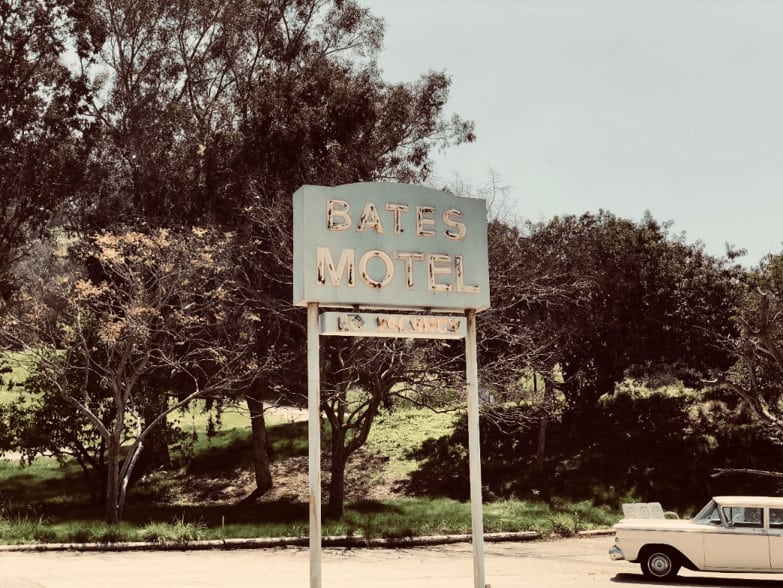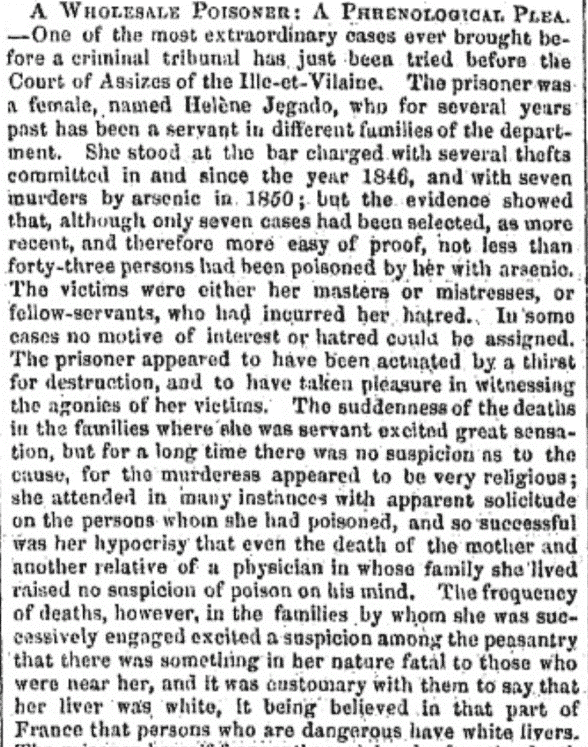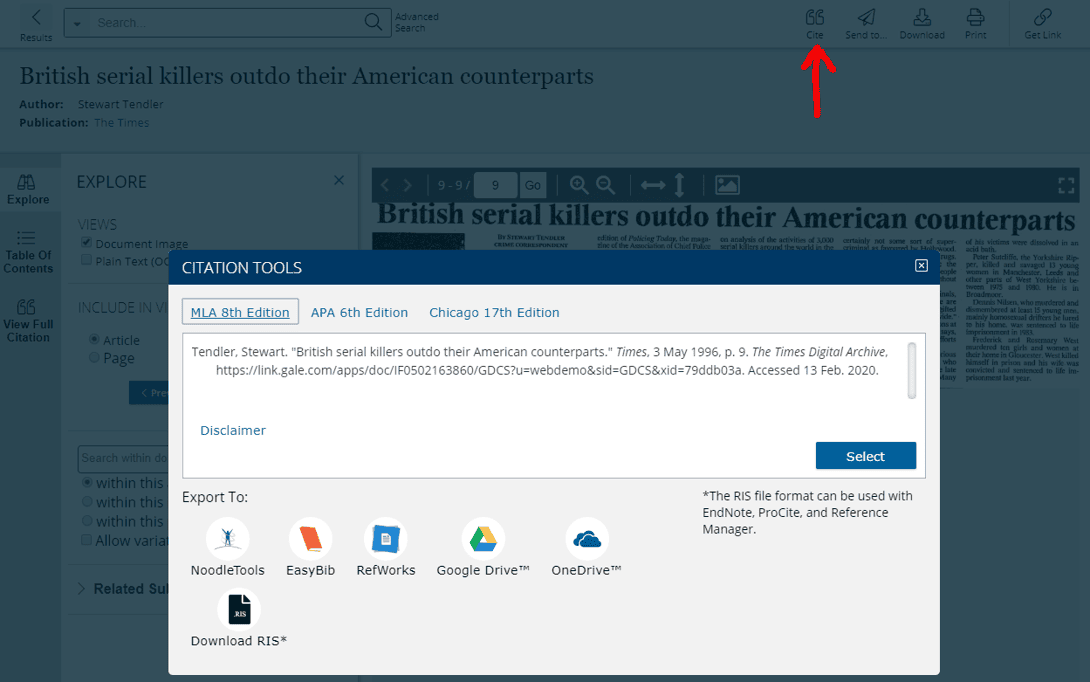│By Chloe Villalon, Gale Ambassador at the National University of Ireland Galway│
In the last decade, television series such as Dexter, Mindhunter and Bates Motel have encountered overwhelming success. Based on true events or completely fictional, the narratives are told from the investigators’ or killer’s perspective. The public is not only interested in the gory, bloody aspect of serial killing cases but the science behind understanding and catching serial killers. Many such programmes try to answer the key question: Why do serial killers kill? Using Gale Primary Sources and its many research tools, I will use this blog post to explore the topic of serial killers, considering questions such as: where does the term “serial killer” come from and what does it mean? And what is the role of the media in serial killing cases?

Where does the term “serial killer” come from?
Picking the right key words is crucial to conducting efficient research, which is why I find the Term Frequency tool extremely useful. When searching the key words “serial killer,” there are no search results available before 1985, as you can see in the graph below.

This seems odd at first glance, as serial killers existed before 1985. However, if, like me, you have watched the TV series Mindhunter you know that the term “serial killer” was coined in the eighties, and this is what’s reflected in the Term Frequency graph. In order to find out more about where the term “serial killer” comes from, I used the Advanced Search tool and added the words “coin” and “expression” to my previous “serial killer” search. I found this article from The Times Digital Archive through which I learnt that the term was coined by “Robert Ressler, America’s most famous profiler”. Before the term was coined, serial killers used to be called mass murderers which did not reflect the repetitive aspects of such killings.
!["Inside the Mind." Times, 17 Oct. 2002, p. 4[S1]+. The Times Digital Archive,](https://review.gale.com/wp-content/uploads/2020/02/Chloe-V-Serial-Killers-inside-the-mind.png)
Nineteenth-century attitudes to serial killers
There are many famous serial killers who operated in the United Kingdom and in the United States of America, and it is easy to find material on this topic in Gale Primary Sources. Apart from Jack the Ripper, most well-known serial killers were active during the last fifty years. However, serial killing is not a new phenomenon, and not restricted to the US and UK. Hélène Jegado, a French woman who worked as a domestic servant, allegedly poisoned forty-three people with arsenic before getting caught in 1851. This column, published in 1851 by the Preston Chronicle (see image below), gives an account of Jegado’s trial. It suggests her defence was built on phrenological principles, a pseudoscience that involves measuring the cranium to predict mental traits. The defence tried to argue that “the organs of hypocrisy and destructiveness were developed to a high degree which overpowered the moral faculties” and that while she should not be released into society, she should not be sentenced to capital punishment. The judge did not accept that defence and she was condemned to death. It seems that, while the reasons that push some people to murder for apparently no other reason than committing the act itself (i.e. not for profit or for passion) remain enigmatic today, society is more willing to accept arguments of mental illness than two centuries ago.

What makes a serial killer?
According to another article from The Times Digital Archive, “the FBI and Scotland Yard usually define a serial killer as someone who has murdered at least four times.” The article lists several traits that serial killers most commonly share such as “a history of criminality in the family, parental difficulties such as a single mother or an absent father, physical handicaps, an injury, sexual or physical abuse and poor education”.

This gives me the opportunity to write about one of Gale Primary Sources’ best features: the ability to download an OCR (Optical Character Recognition) version of any document. When conducting research, I might have to read dozens of documents and I won’t be able to remember what each and every one of them deals with. By downloading the OCR, I can copy and paste a few sentences that I deem useful into my own document (see screenshot below). And in order to make sure I can go back to the article if needed, I also use the “cite” tool and copy and paste the information it provides – which includes a direct link to the article!


Bottom: The “Cite” tool in Gale Primary Sources.
What part does the media play in serial killing cases?
You have probably heard that many serial killers crave fame and recognition, which is why some of them reach out to the media including Ted Bundy, BTK and the Zodiac Killer. According to William Cash, “[serial killers’] crimes are usually a macabre quest for recognition, with the media interest in each killing bolstering their self-esteem.” In this surprising article, a journalist writes of his correspondence with a convicted serial killer on death row which started because the latter submitted an article to The Times that he wished to be published. Serial killers use the media to get the attention they crave, either by communicating with newspapers or by watching closely any news item that relate to their killings. This has been a problem in numerous investigations, as the media gave information to the public and to the killer that should have been kept secret.

What is even more worrying is that serial killers can now use the expertise shared in documentaries and TV shows to increase their chances of literally getting away with murder. According to this article, the “Craigslist killer” was initially suspected to be a police officer because of his apparent knowledge of crime scene investigation techniques, but police soon realised that anyone who watched crime shows such as CSI could have learnt these techniques. Our morbid obsession with serial killers creates a demand for programmes about such crimes which TV channels and streaming platforms are willing to supply. To conclude, as David Mattin puts it, “We are often fascinated by serial killers, but at the heart of that fascination is the desire to make sense of their horrific crime. Ultimately, though, those attempts are never completely satisfactory; and so the fascination endures.” The question is, does this increase in publication of serial killer-related material encourage serial killers to take action, in the hope that a TV series might be written about them?
Interested in reading more about crime in the archives? Check out: British Media Coverage of American Organised Crime, ‘A Genteel Murderess’ – Christiana Edmunds and the Chocolate Box Poisoning, or ‘The compartment was much bespattered with blood’: the Brighton Railway Murder.
Blog post cover image citation: “Tesco.” Times, 15 Nov. 2003, p. 6[S5]. The Times Digital Archive, https://link.gale.com/apps/doc/IF0503482182/GDCS?u=nli_ttda&sid=GDCS&xid=337cd072

